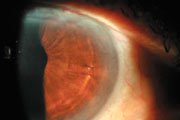Power calculation easy in eyes with phakic refractive IOLs
Four patients had previously implanted Artisan lenses removed before undergoing age-related cataract procedures.
When patients previously implanted with phakic lenses undergo cataract surgery, IOL power calculation is easy and straightforward, according to a Belgian surgeon.
“It’s easy to understand that a lot of our refractive surgery patients will be future cataract patients. Refractive surgeons with some years of experience are now beginning to see their patients returning for old-age cataract treatment. Accuracy of IOL power calculation after refractive procedures is therefore becoming a crucial issue,” Camille Budo, MD, said at the Florence 2003 Annual Symposium on Cataract, Glaucoma and Refractive Surgery.
Easy technique
Corneal refractive surgery can cause difficulty in determining IOL power calculation for cataract procedures. A literature overview reveals many calculations and formulas, which proves that there is no consensus regarding IOL power calculation after photorefractive procedures, according to Dr. Budo.
But cataract surgery after refractive surgery with phakic implants is easier and can have a higher degree of accuracy and predictability, he said.
Dr. Budo’s experience is mostly with the Artisan lens, which he has been implanting for more than 15 years. So far he has had four patients come back for age-related cataract surgery.
“When we remove an Artisan lens 10 years after implantation, we usually see some little marks on the iris. There are no iris atrophy or synechiae between the iris and the lens, but just a slight depigmentation due to the trauma of the enclavation of the Artisan lens,” he said.
To remove the lens, Dr. Budo performs two lateral paracenteses and injects dispersive viscoelastic through a 5-mm limbal incision. He removes the Artisan, “which is not necessarily more difficult than it would have been 10 years earlier just after implantation.”
During removal, he makes sure that the lens does not touch the endothelium. He then reduces the incision to 3 mm and performs a classical phacoemulsification with IOL implantation.
To calculate lens power, Dr. Budo said he uses the SRK-T formula for myopia and the Holladay formula for hyperopia.
Excellent results
Photograph courtesy of Camille Budo, MD. |
Dr. Budo’s first patient to return for cataract treatment was a 49-year-old man who had the Artisan lens implanted in 1999 for hyperopia of +4 D.
“This patient developed posterior synechiae because the convexity of the iris was a contraindication for the Artisan lens. This hindered the final results, and he had a residual refractive error of +1.5 D,” he said. “The visual outcome after he had cataract surgery in 2003 was very positive. He had a residual hyperopia of only +0.5 D and UCVA of nearly 20/20. Keratometry and axial length were unchanged, and the endothelial cell count, which was 2,800 before (phakic) IOL implantation, was 2,500 after cataract extraction.”
The second patient was 48 years old when he was seen in 1993. The next year he was implanted with the Artisan lens for a myopia of –10 D in the right eye and –8.5 D in the left eye, and he achieved emmetropia. In 2003, after cataract surgery, he had only a slight induced astigmatism of 0.75 D in the right eye and a residual myopia of –0.5 D in the left eye. UCVA was near 20/20. Endothelial cell count de-creased slightly in one eye and increased in the fellow eye from a pre-Artisan count of 2,800 to 2,850.
The third patient was implanted with the Artisan in 1995 at age 43. He was –21 D in one eye and –22.5 D in the other eye, and he achieved emmetropia after implantation. In 2003 he had cataract surgery, which left him with –1.25 D in one eye and emmetropia in the other eye. Visual acuity was better than before surgery, and the endothelial cell count was also excellent, said Dr. Budo.
The fourth patient was 52 years old and treated with a phakic IOL implantation for hyperopia of +6.5 D. After implantation he had a residual +0.75 D. Seven years later, he had cataract surgery and ended up with –1 D of induced astigmatism, excellent visual acuity and normal endothelial cell loss, Dr. Budo said.
For Your Information:
- Camille Budo, MD, can be reached at Sint-Godfriedstraat 8, (Sint-Truiden), Melveren 3800, Belgium; +32-11-689684; fax: +32-11-688286; e-mail: camille.budo@skynet.be. Dr. Budo is a paid consultant for Ophtec.
- Ophtec BV, manufacturer of the Artisan lens, can be reached at Ophtec BV, Schweitzerlaan 15, 9728 NR Groningen, The Netherlands; +31-50-525-1944; fax: +31-50-525-4386; Web site: www.ophtec.com.
- Florence ’03, the Annual Symposium on Cataract, Glaucoma and Refractive Surgery, was sponsored jointly by Ocular Surgery News, the International Society of Refractive Surgery and the Italian Association of Cataract and Refractive Surgery. The 9th Annual Joint Meeting of Ocular Surgery News, Italian Association of Cataract and Refractive Surgery and International Society of Refractive Surgery will be held on May 20-22 in Naples, Italy. For information, contact Registration Manager +1-856-848-1000; e-mail: meetingregistration@slackinc.com.

